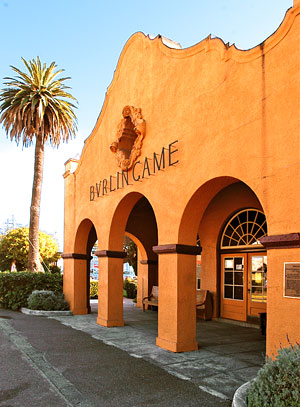National Register of Historic Places in San Mateo County
Burlingame Railroad Station
290 California Drive
Burlingame
Built 1894
In September 1893, the wealthiest young men of San Francisco organized the Burlingame Country Club, the first country club on the West Coast. Its members considered the small flag-stop shelter at Oak Grove inadequate and began negotiations with the Southern Pacific Railroad Company for a more satisfactory station. To achieve a worthy structure an agreement was made with the railroad whereby the club would be responsible for the design and construction of the station.
A. Page Brown, a gifted architect and member of the club, was an inspiration for George H. Howard, Jr., and J. B. Mathison, who volunteered to design the station.
Brown's design for the California building at the Columbian Exposition in Chicago in 1893 had focused national attention of the new Mission Revival movement. He had used a combination of stylized New World Franciscan forms executed in rough stucco to imitate adobe. Details of Brown's design, such as, the tile roof, long arcades, and mission details with certain pseudo-Moorish details are repeated in the Burlingame railroad station.
An essential ingredient of Mission Revival style, the tile roof of the station, is all genuine, mission Indian-handmade tile. For the main roof tiles salvaged from Mission Dolores' assistencia nearby were used. For the residence wing of the station tiles from the decaying remnants of Mission San Antonio de Padua were acquired.
The station design captures characteristics of various California missions: round arches and wide arcades; a false scalloped gable crowning the trackside façade; a wide roof overhang; projecting beams; a variety of window styles including Palladian and a copy of the star window at Mission Carmel. The central tower was possibly dervied from the newly built Stanford University Quadrangle.
There is a roof garden, or terraced roof, but no means was ever provided for getting to it. California missions never had fireplaces, so the chimneys at the Burlingame station are an original solution and became a characteristic of the style. An important introduction, a craftsman influence, was the deliberate use in the interior waiting room of open, exposed beams.
Pioneer construction features included balloon framing and diagonal redwood siding, tar paper, and chicken wire coated with heavy, rough pebble stucco to simulate plastered adobe.
For more than a decade the station stood in an open environment. Standing alone in the open field provided the right setting for the distinctive simplicity of the mission style building. The present Burlingame Avenue then bordered with eucalyptus and cypress trees led directly to the station. Its dirt path was dust in summer and mud in winter. Any summer day at train time the station was surrounded by an array of elaborate horse drawn vehicles and later by the first motor vehicles.
The growth of a city around the station was not a part of the club's concept. The 1906 earthquake did no damage to the station, but a commuter community suddenly burgeoned around the isolated station. The rapid growth of the middle class communities of Burlingame and San Mateo threatened the atmosphere treasured by the Burlingame Country Club members. As a measure of defense the Town of Hillsborough surrounding the club was incorporated in 1910.
Adapted from the NRHP nomination dated 29 November 1977.

CNN Money listed Hillsborough as first in its list of 25 Top-Earning Towns in the United States. CNN Money notes that:
The expression "if you have to ask how much, you probably can't afford it" aptly sums up the town of Hillsborough. And the leaders here plan to keep it that way. Homes in this northern California enclave can be no smaller than 2,500 feet and no lot is less than half an acre. Moreover, you can't have an apartment here no matter what you can afford - town regulations forbid them, along with condos and townhouses. Bing Crosby hung his fedora here, and Hearst heiress Patty, in her pre-SLA kidnapping days, grew up in Hillsborough.

The Burlingame Railroad Station is also California Landmark 846.

Burlingame
Keeler
Menlo Park
Millbrae
San Carlos
Valley Springs
